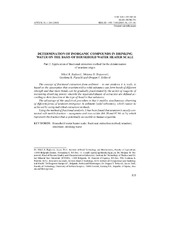Determination of inorganic compounds in drinking water on the basis of household water heater scale
Određivanje neorganskih jedinjenja u vodi za piće ha bazi kamenca
| dc.creator | Rajković, Miloš | |
| dc.creator | Stojanović, Mirjana D. | |
| dc.creator | Pantelić, Gordana K. | |
| dc.creator | Tošković, Dragan V. | |
| dc.date.accessioned | 2020-12-17T18:26:19Z | |
| dc.date.available | 2020-12-17T18:26:19Z | |
| dc.date.issued | 2005 | |
| dc.identifier.issn | 1450-7188 | |
| dc.identifier.uri | http://aspace.agrif.bg.ac.rs/handle/123456789/913 | |
| dc.description.abstract | The concept of fractional extraction from sediment - in our analyses it is scale, is based on the assumption that uranium with a solid substance conform bonds of different strength and that these bonds can be gradually fractionated by the action of reagents of increasing dissolving power whereby the separated phases of extraction are defined according to their function or the type of bond in that substance. The advantage of this analytical procedure is that it enables simultaneous observing of different forms of uranium emergence in sediment (solid substance), which cannot be achieved by using individual extraction methods. Using the method of fractional analysis, it has been found that uranium is mostly connected with mobile fraction - manganese and iron oxides (94.20 and 87.96 wt.%) which represents the fraction that is potentially accessible to human organism. | en |
| dc.description.abstract | Princip frakcione ekstrakcije iz sedimenta, u slučaju naših ispitivanja kamenca, zasniva se na shvatanju da uran može da formira sa čvrstom supstancom veze različite jačine i da te veze mogu biti postupno raskinute delovanjem reagenasa rastuće jačine, pri čemu se pojedinačne faze ekstrakcije definišu na osnovu njihove funkcije ili oblika vezanosti u toj supstanci. Prednost ovog analitičkog postupka je u tome što omogućava istovremeno sagledavanje različitih oblika pojavljivanja urana u sedimentu (čvrstoj supstanci), što se ne može postići primenom pojedinačnih ekstrakcionih metoda. Metodom frakcione ekstrakcije, primenjenom u ovom radu utvrđeno je da je uran najviše vezan za potencijalno-pristupačnu i mobilnu frakciju - okside gvožđa i mangana (94,20 odn. 87,96%), što predstavlja frakciju koja je potencijalno pristupačna ljudskom organizmu. | sr |
| dc.publisher | Univerzitet u Novom Sadu - Tehnološki fakultet, Novi Sad | |
| dc.relation | Projekat Ministarstva nauke Republike Srbije, br. 1941 | |
| dc.rights | openAccess | |
| dc.rights.uri | https://creativecommons.org/licenses/by-nc-nd/4.0/ | |
| dc.source | Acta periodica technologica | |
| dc.subject | household water heater scale | en |
| dc.subject | fractional extraction method | en |
| dc.subject | uranium | en |
| dc.subject | strontium | en |
| dc.subject | drinking water | en |
| dc.title | Determination of inorganic compounds in drinking water on the basis of household water heater scale | en |
| dc.title | Određivanje neorganskih jedinjenja u vodi za piće ha bazi kamenca | sr |
| dc.type | article | |
| dc.rights.license | BY-NC-ND | |
| dc.citation.epage | 141 | |
| dc.citation.issue | 36 | |
| dc.citation.other | (36): 135-141 | |
| dc.citation.spage | 135 | |
| dc.identifier.doi | 10.2298/APT0536135R | |
| dc.identifier.fulltext | http://aspace.agrif.bg.ac.rs/bitstream/id/4401/910.pdf | |
| dc.type.version | publishedVersion |


